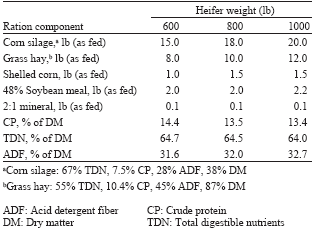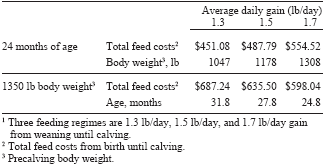



Management Considerations in Holstein Heifer Development
By Michael Looper, Extension Dairy Specialist, Greg Bethard, Technical Services Specialist, Monsanto Dairy Business, College of Agriculture and Home Economics. Table of Contents
Table of Contents
Why 1250 pounds?
Why 24 Months?
Monitor gains
Rations
Economics of 1250 pounds at 24 months
Summary
References
The purpose of the heifer herd is to provide replacements for cows leaving the herd and to improve genetic progress. First-lactation cows significantly contribute to herd production and profit. A recommended goal for dairy replacement heifers is to calve at 24 months of age with a targeted post-calving body weight of 1250 pounds. A common misconception is that this goal is either unattainable or uneconomical. Feeding heifers for rapid gains costs more per day than feeding for low gains, but development of replacement heifers is an investment in the future. The replacement heifer program should rear heifers to reach a desired age and body weight at a minimum cost.
Why 1250 pounds?
Why should producers strive for a target weight of 1250 pounds after calving? A large field study conducted from 1980 to 1984 involving DHIA records found that Holstein heifers calving between 1195 and 1250 pounds had the greatest first-lactation milk yield (Keown and Everett 1986). The importance of achieving calving weight goals is illustrated by the dramatic decline in milk yields when post-calving weights were below 1100 pounds (fig. 1). A first-lactation cow that weighs 1250 pounds produces 1775 pounds more milk than a first-lactation cow calving with a weight of 900 pounds or less. Calving weight had a greater impact on first-lactation performance than did calving age, suggesting heifers should be bred by weight, not age.Over 50,000 DHIA records from Virginia were evaluated to determine the relationships between age at first calving, post-calving body weight, and first-lactation milk yield (Bethard 1997). Optimum first-lactation milk yield occurred when post-calving body weight was approximately 1200 to 1300 pounds, independent of calving age (fig. 2). However, milk yields declined when post-calving body weight exceeded 1300 pounds, suggesting that over-conditioned heifers have lower milk yields than well-conditioned heifers.
These results support the recommended 1200- to 1250-pound post-calving target weight. It is important to remember that a 1200- to 1250-pound post-calving weight translates to a 1300- to 1350- pound pre-calving weight. Heavier heifers produce more milk than smaller heifers because they have less growth remaining to reach mature body size, so nutrients can be used for milk production instead of growth. Smaller heifers also may take in less feed at the feed bunk due to competition from heavier, more aggressive heifers.
Over-conditioned heifers also perform poorly (fig. 2). Fat heifers can be predisposed to fatty liver, which can lead to ketosis and reduced feed intake. Over-conditioned heifers have low lactation performance and a high incidence of dystocia, or difficult labor (Hoffman et al. 1996).
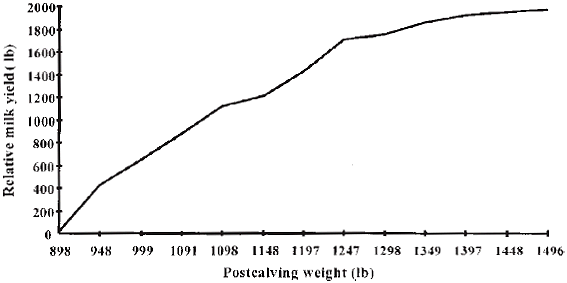
Why 24 Months?
It is well established that heifers should be between 23 and 26 months of age at first calving. Heifers that calve early spend more of their life producing milk than heifers that calve late. A large investment ($1150 to $1200) is required to rear heifers from birth to calving, and monthly cost thereafter is $55 to $65 (Keown and Everett 1986). The earlier heifers enter the milking herd, the sooner the return on the initial investment. Greater age at first calving dramatically increases herd costs. An extra day to first calving is estimated to cost 13 times as much as an extra day open (Cady and Smith 1996). Delayed calving can increase rearing costs $50 per heifer for each month beyond 24 months (Smith 1993).The number of replacements needed to maintain herd size increases when calving is delayed (table 1). Assuming a 30 percent cull rate, increasing age at first calving from 24 to 28 months requires 11 percent more heifers to maintain herd size, or 110 more heifers on a 1000 cow dairy. Alternatively, decreasing age at first calving from 28 to 24 months results in 110 surplus heifers that can be sold. Heifers should calve between 22.5 and 23.5 months of age to maximize lifetime performance (Gill and Allaire 1976).
What About 21 Months?
Calving before 21 months can be a risky option due to problems associated with rapid growth. Since calving weight, not calving age, is the major factor affecting first-lactation milk yield, successfully calving heifers at 21 months would require daily gains near 2.0 pounds/day from birth to calving for large-breed heifers. To reduce calving age to 21 months, age at first breeding must be reduced to 11 to 12 months, which would require excessive pre-pubertal gains to achieve breeding weight goals. Body weight gains in excess of 2.0 pounds/day can be detrimental to mammary development in heifers under 12 months of age (Sejrsen et al. 1982).
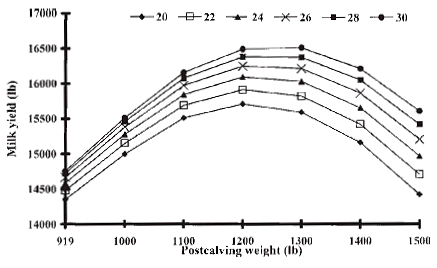
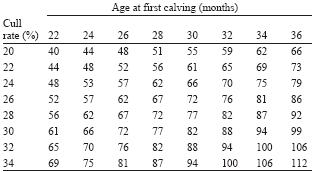
Attaining 1250 Pounds in 24 Months
Heifers must gain an average of 1.7 to 1.8 pounds daily from birth to calving to achieve a pre-calving weight of 1350 pounds. Overall feeding cost from weaning to calving is less when heifers are fed to gain 1.7 pounds/day than when they are fed to gain 1.3 or 1.5 pounds/day (table 2). Remember, a 1250-pound post-calving weight translates to about a 1350-pound pre-calving weight. This goal is attainable with intensive management, even with less than optimal facilities and feed quality.Weaning to Breeding
Age at onset of puberty is positively related to body weight. Sexual maturity of Holstein heifers begins at approximately 550 to 650 pounds, independent of age. Consequently, nutrition has a dramatic effect on age at puberty and first breeding. Too little or too much body weight gain during this growth period is a problem.
Low body weight gains pose a problem. Low weight gain before breeding is an obvious problem because it delays puberty, breeding, and calving. Average daily gains between 1.5 and 1.7 pounds are necessary to achieve a breeding weight goal of 800 pounds at 14 months of age for large-breed heifers. Therefore, an average daily gain below 1.5 pounds for large-breed heifers is unacceptable and costly because it delays sexual maturity.
Rapid body weight gains are risky. Gains greater than 2.0 pounds/day for large-breed heifers prior to puberty are risky. Holstein heifers fed diets to gain 2.8 pounds/day had larger mammary glands, but less total secretary tissue due to increased mammary adipose (fat) tissue than heifers gaining 1.4 pounds/day (Sejrsen et al. 1982). Growth rate did not influence mammary composition when similar treatments were applied to post-pubertal heifers. Pre-pubertal heifers gaining 2.2 pounds/day between 19 and 39 weeks of age had less (7.1 percent) first lactation fat-corrected milk than heifers gaining 0.9 pounds/day (Lammers et al. 1999).
Excessive pre-pubertal gains can reduce milk yield during the first and later lactations due to a lack of secretary tissue in the mammary gland. However, critics argue that heifers in these studies were fed for an unusually high rate of gain approaching that of feedlot cattle. Research consistently supports the theory that rapid pre-pubertal gains impair mammary development, although gains are greater than the normal range in many studies. Sejrsen and Purup (1997) suggest further research is needed to understand the relationship between nutrition and mammary development. Limited research suggests no correlation between rapid pre-pubertal weight gains and impaired mammary development when high crude- protein diets are fed (VandeHaar 1997; Waldo et al. 1998). Further research is needed to recommend rates of gain exceeding 1.8 pounds/ day for pre-pubertal dairy heifers. The recommendation for average daily gains for growing dairy heifers prior to puberty is between 1.5 and 1.8 pounds/day.
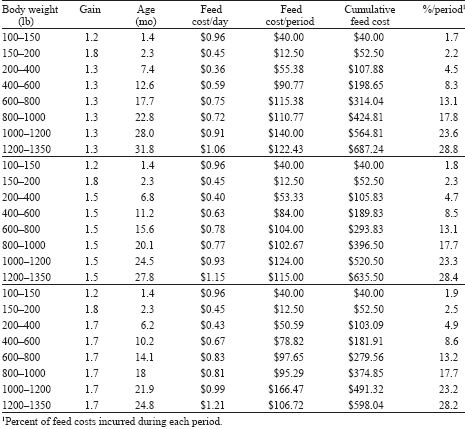
Breeding-Age Heifers
An ideal time to evaluate heifers for body weight, wither height, and body condition is at breeding. Other than the pre-weaning period, this is one of the few times when heifers are observed closely. Heifers need to be bred in a timely fashion (14 to 15 month average age at first breeding) to achieve a successful replacement program. Conception by 14 to 15 months is necessary if heifers are to calve by 23 to 26 months of age. Heifers need to gain weight (1.5 to 2.0 pounds/ day) and have adequate body condition to achieve high conception rates. Rations should be balanced in energy (64 to 68 percent TDN, or total digestible nutrients) and protein (13 to 15 percent).
Conception problems occur when heifers experience weight loss or are in poor body condition. Balancing rations is critical to avoid these problems. Heifers leaving confinement also can experience weight loss and low conception rates. Researchers at Virginia Tech found heifers experience a body weight loss of up to 60 pounds for a 1- to 2-month period after leaving a confinement facility and moving to pasture. It may be that the increased exercise on pasture reduces the amount of energy available for growth. Therefore, to avoid breeding problems, breeding should occur either before leaving confinement or 2 months after entering pasture.
Breeding to Calving
Animals with the lowest priority on a dairy farm are usually the bred heifers. This group does not require the intensive management that younger heifers do. Calving dates have already been set, so the major goal is for heifers to gain sufficient body weight to achieve desired calving weight and body condition. Average daily gain must be 1.7 to 2.1 pounds during gestation if heifers were bred at 750 to 850 pounds. Body weight gains above 2.0 pounds/day are acceptable for bred heifers during the first 6 to 7 months of gestation. Body weight gains in excess of 2.0 pounds/day should be avoided 1 to 2 months prepartum to prevent calving and postpartum problems because fetal and mammary growth accelerate during this time. Also, excessive body condition (> 4.0 on a 5-point scale) at calving can lead to postpartum health problems.
Monitor gains
It is essential that body weight gains and wither heights of heifers are monitored due to the narrow window of recommended gains (1.5 to 1.8 pounds/day). A scale or weight tape and a wither height stick should be available to periodically monitor heifer performance at all ages. At a minimum, heifers should be weighed every time they are worked (such as for de-worming, vaccination, and breeding). Recommended body weights and wither heights for growing Holstein heifers at various ages are indicated in table 3.Heifers that achieve body weight goals but are lacking in wither height likely have excessive body condition. Body condition may be difficult to measure objectively, particularly in younger heifers.
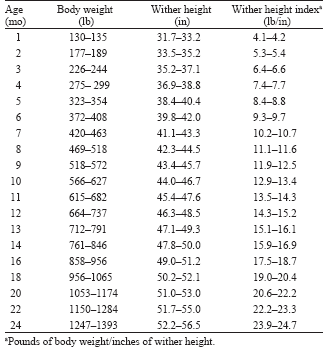
An alternative to visual scoring is to calculate a wither height index (pounds body weight/inches of wither height) to estimate body condition. The subjectivity and bias of body condition scoring are avoided with wither height indices. Average wither height indices for a group of heifers should be similar to those in table 3. Due to the large variation among heifers, producers should monitor groups, not individuals. If wither height indices are low, indicating poor body condition, rations should be evaluated to assure nutrient intake is adequate. A common cause of high wither height indices (excessive body condition) is a diet deficient in protein but excessive in energy. Many corn silage–based diets are in this category.
Rations
Rations formulated to attain a 1.8 pound gain/day are adequate to achieve the pre-calving target of 1350 pounds at 24 months. Three sample heifer rations are shown in table 4. These rations assume that forage quality is average and grain supplementation does not exceed 3.7 pounds/day. High-quality forages require less grain supplementation. Large quantities of grain are not necessary to achieve high rates of gain. The important component is ration balancing, or supplying nutrients in the proper proportions. A ration balanced in energy and protein promotes high rates of lean gain. However, a ration high in energy but deficient in protein can result in high gains, but with excessive condition. Therefore, rations need to be evaluated periodically, as are rations for lactating cows.All three of the sample rations contain a mineral with ionophores, either BovatecTM or RumensinTM. Ionophores improve energy metabolism and protein use in the rumen, resulting in improved gains and/or feed efficiency. Additionally, ionophores have Coccidiostat properties (they reduce and control Coccidia) when fed at recommended dosages (200 mg/day) and are inexpensive to supplement (about 1.2 cents/day).
Some producers have an interest in rearing heifers on pasture. Feed costs can be reduced with pasture without decreasing daily gains. To achieve high rates of gain, pastures must be managed intensively. Rotational grazing can allow heifers to continually consume immature, high quality forage. Mature grasses are lower in quality and will result in lower gains. Holstein heifers (400 to 1000 pounds) grazing orchard grass pasture at the Virginia Tech Dairy Center gained over 2.0 pounds/day while receiving 2 pounds of a 16 percent crude protein corn and soybean meal mix. Gains were improved by feeding RumensinTM in the grain. Researchers at New Mexico State University (Lopez et al. 1999) found dairy heifers can gain 1.75 pounds/day grazing a Kleingrass-alfalfa mixture (no supplementation) during the summer months (June, July, and August).
Economics of 1250 pounds at 24 months
The bottom line for the heifer replacement enterprise is profitability. The benefits of a 1250- pound post-calving weight at 24 months must outweigh the production costs to be profitable. Two questions must be answered: 1) Is it profitable to feed for a 1250-pound post-calving weight?, and 2) For a target calving weight, is it profitable to decrease calving age to 24 months or less?Is it profitable to feed for a 1250 pounds post-calving weight? The benefit of achieving a 1250-pound post-calving weight is increased first lactation milk yield. The increased milk yield should pay for the increased feed costs. Body weight and total feed cost increase as average daily gain increases (table 5). Heifers that averaged 1.7 pounds/day had higher feed costs ($103.44 increase) and pre-calving weights (261 pounds heavier) than heifers that gained 1.3 pounds/day. Heifers with a post-calving body weight of 1250 pounds produced approximately 1000 pounds more in first-lactation milk yield than heifers with a post-calving weight of less than 950 pounds. At $12/cwt for milk, the additional revenue from milk would be $120. Therefore, it would be profitable to achieve a post-calving weight of 1200 to 1250 pounds. However, there is little benefit, and possibly harm, in post-calving weights exceeding 1300 pounds.
Is it profitable to decrease calving age to 24 months or less? Decreasing age at first calving decreases total feed costs from birth until calving, assuming a similar pre-calving weight (table 5). Heifers gaining 1.7 pounds/day were seven months younger at first calving and cost $89.20 less to feed than heifers gaining 1.3 pounds/day. Although early calving heifers had a higher daily feed cost, the total feed cost until calving was lower. This alone is an economic incentive to decrease age at first calving, because milk yields should be similar if body weights are similar. Decreasing first-calving age also increases the number of surplus heifers available to sell (table 1). Heifers that calve early return income (milk sales) sooner than later calving heifers. Considering all the advantages, there is little doubt that reducing age at first calving is profitable. However, calving ages less than 22 months may not be feasible due to the excessive pre-pubertal gains required.
Summary
Development of replacement heifers is critical because first-lactation cows account for between 30 (DRMS, Raleigh, NC) and 38 percent (DHI Computing Service, Provo, Utah) of all milking cows. Research indicates that the goal of dairy replacement heifers calving at 1250 pounds and 23 to 24 months of age is attainable and economically viable. To achieve this goal, heifer growers must monitor gains and routinely evaluate rations. Monitoring performance and balancing rations to provide adequate but not excessive nutrient intake will help ensure well-grown heifers that perform to their potential. Proper management of the heifer herd is one area on most dairy operations in which production costs can be reduced and herd productivity and profitability increased.REFERENCES
Bethard, G.B. 1997. A microcomputer simulation to evaluate management strategies for rearing replacement heifers. Ph.D. Dissertation, Virginia Tech.
Cady, R.A. and T.R. Smith. 1996. Economics of heifer raising programs. Proc. NRAES Conference on Calves, Heifers, and Dairy Profitability: Facilities, Nutrition, and Health. Harrisburg, PA.
Gill, G.S. and F.R. Allaire. 1976. Relationship of age at first calving, days open, days dry, and herdlife to a profit function for dairy cattle. J. Dairy Sci. 59:1131.
Hoffman, P.C., N.M. Brehm, S.G. Price, and A. Prill-Adams. 1996. Effect of accelerated postpubertal growth and early calving on lactation performance of primiparous Holstein heifers. J. Dairy Sci. 79:2024.
Keown, J.F. and R.W. Everett. 1986. Effect of days carried calf, days dry, and weight of first calf heifers on yield. J. Dairy Sci. 69:1891. Lammers, B.P., A.J. Heinrichs, and R.S.
Kensinger. 1999. The effects of accelerated growth rates and estrogen implants in prepubertal Holstein heifers on estimates of mammary development and subsequent reproduction and milk production. J. Dairy Sci. 82:1753.
Lopez, R., C. Krehbiel, C. Barnes, E. Hanson, E. Castellanos, I. Hernandez, K. Duncan, G. Donart, and R. Flynn. 1999. Effect of grass legume pasture on forage availability and quality, and growth of Holstein heifers. Proc. Western Sec. Amer. Soc. Anim. Sci. 50:173.
Sejrsen, K., J.T. Huber, H.A. Tucker, and R.M. Akers. 1982. Influence of nutrition on mammary development in pre- and postpubertal heifers. J. Dairy Sci. 65:793.
Sejrsen, K. and S. Purup. 1997. Influence of prepubertal feeding level on milk yield potential of dairy heifers: a review. J. Anim. Sci. 75:828.
Smith, T.R. 1993. Dairy replacement economics. Proc. Northeast Heifer Management Symposium. Syracuse, NY. p 117.
VandeHaar, M.J. 1997. Dietary protein and mammary development of heifers: analysis from literature review. J. Dairy Sci. 80(Supp. 1):216.
Waldo, D.R., A.V. Capuco, and C.E. Rexroad, Jr. 1998. Milk production of Holstein heifers fed either alfalfa or corn silage at two rates of daily gain. J. Dairy Sci. 81:756.
July 2000

